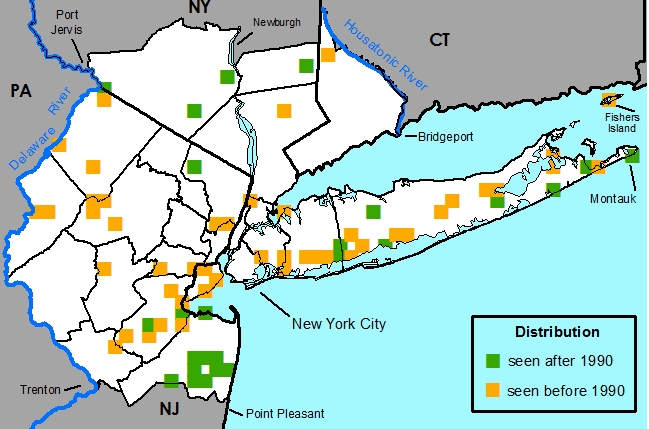Ilex laevigata (Pursh) Gray - Smooth Winterberry
Common Names
Smooth WinterberryField Identification
Deciduous shrub to 3 m tall with alternate, simple, hairless and somewhat glossy leaves with small teeth and with red fruits on female specimens; most easily confused with Ilex verticillata.Food uses
Disclaimer: The information provided here is for reference and historical use. We do not recommend nor do we condone the use of this species for food purposes without first consulting a physician.Medicinal uses
Disclaimer: The information provided here is for reference and historical use. We do not recommend nor do we condone the use of this species for medicinal purposes without first consulting a physician.Other uses
Rarely used in cultivation, its sister species I. verticillata is much more commonly encountered in landscape situations.
Poisonous properties
Disclaimer: The information provided here is for reference and historical use. If you believe you have been poisoned, please contact the Poison Control Office near you (look for the number in the front of the phone book).
Ilex fruit and leaves contain an array of potential toxins which can cause moderate to severe nausea, vomiting, diarrhea, and rarely narcosis. Death is unlikely.
Nomenclature
Ilex laevigata A.Gray, Manual ed. 2, 264. 1856.
?Prinos lanceolatus J. Hill. Veg. Syst. 16: 57. pl. 61. 1770.
Prinos laevigatus Dum.Cours., Bot. Cult. ed. 2, 6: 255. 1811.
?Ilex lanceolatus Chapm. Fl. South. U.S. 1860.
Prinos nitida Hort. ex K. Koch, Dendrologie 2,1: 227. 1872.
TYPE: unknown
Ilex laevigata f. herveyi B.L.Rob. in Rhodora, 10: 34. 1908.
TYPE: USA, Massachusetts, Lakeville: E. W. Hervey s.n. (Holotype: GH).
Description
HABIT Perennial, deciduous, phanerophytic, shrub, diclinous and dioecious, 1-3 m tall.
STEMS Main stems erect, round. Bark smooth, not exfoliating. Branches erect or ascending. Twigs dark brown, not odoriferous, terete, 2-4 mm in diam., smooth, glabrous, eglandular. Pith white, round, nodal diaphragm absent. Sap translucent.
BUDS Terminal and axillary scattered along stem; axillary buds 1 per axil. Bud scale scars not encircling the stem. Leaf scars crescent-shaped; bundle-traces 1.
LEAVES Alternate, simple, spiral, 1 per node, crowded toward stem apex or spaced somewhat evenly along stem, divergent from stem. Stipules present, lateral, deciduous, scale-like, minute, caduceus, dropping shortly after buds open. Leaves petiolate, petiole terete, 0.5-1 cm long, glabrous or with long and unbranched erect or spreading hairs, sparse or moderately dense, distributed throughout. Not glabrescent, eglandular. Leaf blades: abaxial surface light green, adaxial surface green, elliptic or obovate, bilaterally symmetric, 3-8 cm long, 2-4 cm wide, membranaceous, base cuneate, margins toothed, serrulate, apex cuspidate, abaxial surface glabrous or with long and unbranched erect or spreading white hairs, sparse or moderately dense, distributed along midveins, eglandular. Adaxial surface glabrous. Venation brochidodromous.
INFLORESCENCES Unisexual, simple, consisting of a single flower or fascicle, usually 1 flower per axile. Peduncle 0.3-0.5 cm long; glabrous, eglandular.
FEMALE FLOWERS Sepals and petals readily distinguishable from one another, more than 5-merous, 5 mm long, 5 mm wide, 1 flower per inflorescence, occasionally 2 flowers per axile, fragrance absent. Calyx actinomorphic, persistent. Sepals 6-8, triangular, margins entire, abaxial surface glabrous, eglandular. Corolla actinomorphic, deciduous, abaxial and adaxial surfaces light greenish yellow or white. Petals 6-8. Margins entire, abaxial and adaxial surfaces glabrous, eglandular. Gynoecium syncarpous. Style and stigma 1, stigma capitate. Ovary superior, glabrous. Placentation axile. Androecium abortive, rudimentary and sterile.
MALE FLOWERS Fascicled, axillary. Peduncle present. Pedicel 5-12 mm long, glabrous, eglandular. Flowers 4 mm long, 5 mm wide, perianth of two whorls. Calyx actinomorphic, persistent. Sepals 6-8, triangular, margins entire, glabrous, eglandular. Corolla actinomorphic, deciduous, abaxial and adaxial surfaces light greenish yellow or white. Petals 6-8, margins entire, glabrous, eglandular. Stamens 6-8. Anthers opening along the long axis, yellow. Filaments free, eglandular. Gynoecium vestigial.
FRUITS Drupe, red or orange-red ( f. herveyi has yellow fruit), globose, 7-10 mm long, 7-10 mm wide, glabrous, eglandular.
SEEDS Pale brown, narrowly elliptical in outline; trigonal in cross section, 4 mm long, 2 mm wide, glabrous, eglandular.
Habitat
Bogs, swamps, stream/pond shores, wet woods, usually in well drained, acidic soil.Distribution
Native to eastern coastal United States.
United States -- CT, DE, MA, MD, ME, NC, NH, NJ, NY, PA, RI, SC, VA, VT?
New York Metropolitan Region -- Native, historically distributed throughout the metropolitan area, now found mainly on the coastal plain.
Rarity Status
Heritage global rank -- G5
Connecticut -- Not listed
New Jersey -- Not listed
New York -- Not listed
Species Biology
Flowering
June [week 1] - July [week 1]
Pollination
Probably Mellittophily
Fruiting
July [week 2] - October [week 3] - following Spring?
Dispersal
Endozoochory -- Avian frugivores[probably same species as I. verticillata]: Anas platyrhynchos (Mallard), Anas rubripes (American Black Duck), Coccothraustes vulgaris (Evening Grosbeak), Sialia sialis (American Bluebird), Sphyrapicus varius (Yellow-bellied Sapsucker), Turdus migratorius (American Robin)
Germination
In nature, holly seeds usually germinate from 1-3 years after dispersal, and natural regeneration commonly is sparse. The seeds have hard seed coats and dormant or immature embryos; as a rule they are difficult to germinate. Germination is probably epigeous. Satisfactory germination results have been attained for I. verticillata by first stratifying the seeds in moist sand for 60 days (68 degrees F at night, 86 degrees F by day) followed by 60 days at 41 degrees F; this treatment regimen would probably work for I. laevigata.
